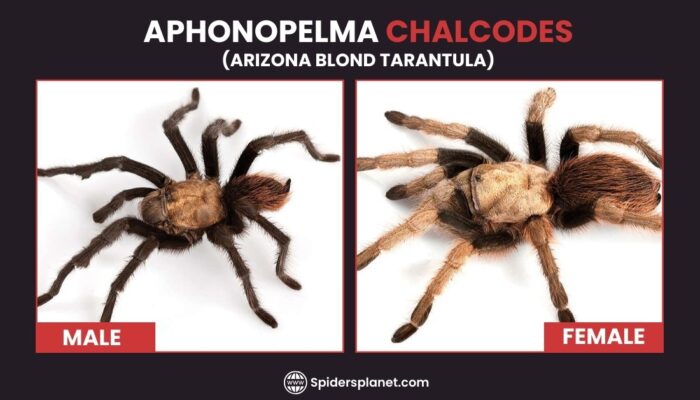The Arizona Blond Tarantula (Aphonopelma chalcodes), also referred to as the western desert tarantula or Mexican blonde tarantula, is a captivating spider indigenous to the arid regions of the American Southwest and northern Mexico.
With a striking mix of golden hairs, dark chocolate tones, and dark grey shades, this desert dweller, boasting a leg span of 3-4 inches, is a visual delight.
Despite its name, the Arizona Blond Tarantula is not only about appearance; it is renowned for its docile nature and relatively easy care, making it a favorite among tarantula enthusiasts.
Stay with us as we explore the secrets and unique characteristics, i.e. its scientific name, appearance, habits, where it lives, what it eats, how it behaves, its life cycle, and some interesting facts about this amazing creature that lies beneath the shimmering surface of this extraordinary creature.
Interesting Facts – Arizona Blond Tarantula
- Among the largest spiders in North America.
- Dark chocolate colored bodies covered in blonde hairs.
- They do not spin webs but hide and ambush prey.
- Females can lay 200-800 eggs at once.
- The Arizona Blond Tarantula typically has a leg span of 3-4 inches.
- These terrestrial burrowers are primarily active at night.
- Females of this species have a longer lifespan, ranging from 20 to 30 years, while males typically live for 5-10 years.
- Relatively weak venom, not dangerous to humans.
- Poor eyesight relies on touch and vibration for sensing.
- Cannibalistic behavior may eat other tarantulas when hungry.
Arizona Blond Tarantula Description:
Scientific Name, Specie, and Family:
Arizona blond tarantula has the scientific name Aphonopelma chalcodes and is widely recognized as desert tarantula, western tarantula, and Mexican blonde tarantula, belonging to the Animalia kingdom and falling under the phylum Arthropoda.

More specifically, it is classified in the class Arachnida within the Theraphosidae family. It is identified by the genus Aphonopelma, and its specific species is Aphonopelma chalcodes.
The name “blonde tarantula” comes from the top part of the spider, called the carapace, which is covered in light-coloured hairs. This stands out because the legs and abdomen are dark.
Body:
Let’s take a closer look at its body structure: The front part called the cephalothorax, houses the brain and eight legs, with powerful fangs for hunting on its “head”.
The segmented abdomen holds vital organs and is covered in protective golden hairs. With four pairs of strong legs, equipped with sensory hairs, it can walk, climb, and burrow.
Defensive hairs found on certain tarantulas can cause irritation or a stinging sensation when touched; these protective hairs are concealed beneath the tarantula’s outer layer of golden-colored hair. It is a mechanism tarantulas use for defense against perceived dangers.
Molting is a crucial process for growth, and spinnerets enable silk production for various purposes. The Aphonopelma chalcodes’ detailed body shows how well it can live in the dry desert, proving how clever nature is in helping creatures survive.
Arizona Blond Tarantula Appearance:
Size and Color:
These Arizona tarantulas come in distinct colors and sizes. The female displays a uniform tan color, reaching a body length of up to 56 mm.
In contrast, the male features black legs, a copper-colored cephalothorax, and a reddish abdomen, with a smaller body size, reaching a maximum of 44 mm.
Their silk-lined burrow entrances, ranging from 1 to 2 inches (25 to 51 mm) wide, are distinguished by strands of silk at the opening.
Vision and Sensory Adaptations:
Desert tarantulas use two sets of eyes to spot colors and light differences. Their eyes are super sensitive, letting them tell apart different colors of light.
Scientists found that they are most sensitive to light around 500 nm but less so at 640 nm. When capturing prey, they inject it with unique fluids, transforming the animal’s internal state.
Both sets of eyes kind of work the same way, like how other animals’ eyes use rods and cones.
The tarantula’s additional eyes possess tapeta, aiding improved vision in low-light conditions. All of this is really important for the tarantula to move around and find food in its home.
What They Like to Eat or Hunt?
Arizona Blond Tarantulas feast on other animals. They are not picky eaters; whatever comes near their burrows might become their next meal.
These clever tarantulas hang out at the entrance of their burrows, patiently waiting for something tasty to stroll by.
Their menu includes insects, grasshoppers, beetles, small lizards, cockroaches, crickets, mice, and even scorpions.
When they catch their prey, they inject it with special juices that turn the animal into a liquid. Then, they slurp up all the nutritious goodness.
Habitat and Adaptation:
The Aphonopelma chalcodes inhabit several states in the southwestern United States, notably in New Mexico and Arizona.
These spiders prefer living in desert soil and are tough enough to endure harsh weather conditions. They build deep burrows to help them cope with changes in temperature.
Arizona Blond Tarantulas are clever creatures. By digging into the sand, they can control their body temperature.
They prefer staying in their burrows during the day and emerge at night to search for food. These tarantulas are loners, with just one living in each burrow.
They usually stay close to their homes, except during the mating season when male tarantulas venture out to find a mate.
Behavior:
Tarantulas, like the Aphonopelma chalcodes, use silk differently than most spiders. Instead of making webs, they produce silk from special glands in their feet.
These tarantulas dig holes in the ground and cover the entrance with silk. They remain concealed in their burrows during the day, emerging at night to search for food.
Nocturnal Behavior:
When it gets dark, the western desert tarantula, Aphonopelma chalcodes, starts its activities. This happens when the silk covering its burrow is broken.
The silk can break because the spider has its own internal clock (like a built-in timer), it gets darker outside, or the temperature changes.
During the night, these tarantulas patiently linger near their burrow entrances, awaiting prey. As dawn breaks, they retreat into their burrows.
Even though they love the night, you might also catch them chilling near their burrow in the early morning, proving they are not only active at night.
Reproduction, Babies, and Life Cycle:
Male tarantulas mature at 10 to 12 years old and leave their burrows to find a mate. When locating a mature female’s burrow, the male signals his presence through silk stroking and tapping recognizable patterns.
Mating is precarious for the male, involving careful depositing of sperm using a special part called a pedipalp. After mating, the male quickly retreats, aware of the potential danger from the female.
Female tarantulas lay a significant number of eggs, ranging from 200 to 800, and carefully encase them in a protective silk covering.

These eggs take about two months to grow, with the mother tarantula keeping a close eye on them.
Baby tarantulas: After hatching, the spiderlings, as the baby tarantulas are called, remain with the mother for a couple of weeks under her watchful gaze before going their separate ways to build their own burrows.
Interestingly, spiderlings are not born with the dark and blonde appearance characteristic of adults but start off as entirely white. It takes a few days for them to develop their distinctive coloration.
While equipped to eat the same food as adult tarantulas, they learn to target smaller prey as they grow.
In Arizona’s summer rains, male tarantulas seek mates, but their post-mating life is short, often becoming a meal for females.
Whether in captivity or the wild, males live only a few months after finding a mate. Females shed their skin annually, requiring a new mate for fertile eggs and restarting the reproductive cycle.
Predators:
Arizona Tarantulas have some tough foes, i.e., snakes, lizards, birds, coyotes, foxes, and even tarantula hawks (a type of wasp) are their predators.
Arizona Blonde Tarantula Bite and Venom:
These spiders are venomous. The venom of the Aphonopelma chalcodes, like many spiders, contains substances that can be useful for creating insecticides and medicines.
In particular, the venom has two compounds called Apc600 and Apc728, which contain substances like spermine and 1,3-diaminopropane.
Although these toxins have not been studied much, scientists think they might work to temporarily paralyze or immobilize the tarantula’s prey.
Crucially, the venom of the Aphonopelma chalcodes is not highly dangerous to humans, causing effects similar to a bee sting.
Are they Good Pets?
Arizona Blond Tarantulas (Aphonopelma chalcodes) are considered good pets due to their calm nature, ease of care, and long lifespan of 20-30 years.
They are fascinating to observe, although not social creatures. Owners should be aware of their specific environmental needs and the potential for bites, even though they are generally docile.
Enclosure and Care:
Creating an optimal environment for your Aphonopelma chalcodes involves several key elements:
- Size: Adults are comfortable in a 10-gallon terrarium or critter keeper.
- Substrate: Use 3-4 inches of dry coconut fiber or peat moss for bedding.
- Humidity: Keep a moderate humidity level between 60-70%.
- Hides: Include a hideout, like cork bark or a half-log, for comfort.
- Water: Provide a shallow water dish at all times.
- Temperature: Maintain a room temperature ranging from 70-80°F (21-27°C).
- Ventilation: Ensure proper ventilation to prevent moisture buildup.
- Secure Lid: Use a secure lid to prevent escapes and promote a sense of security for the tarantula.
Male Vs. Female – Arizona Blond Tarantula

| Features | Male | Female |
| Color | Uniform light brown/tan | Black legs, copper cephalothorax, reddish abdomen |
| Body size and shape | Larger, stockier | Smaller, lankier |
| Hair | Fine, less noticeable | Fine, longer on legs, especially first pair |
| Activity level | Less active, stays in burrow | More active, nomadic during mating season |
| Molting | Once a year | More frequent, especially when young |
| Lifespan | 20-30 years | Few months after mating |
FAQs:
How potent is the venom of Arizona blonde tarantulas?
Arizona blonde tarantulas possess mild venom, akin to a bee sting for humans. While its venom can lead to localized pain, swelling, and redness, severe health problems are rare.
Do Arizona blonde tarantulas construct webs?
Unlike many tarantula species, Arizona blondes do not build webs. They rely on burrows for shelter and ambush hunting, occasionally spinning silk threads near the burrow entrance for stability.
Is it possible to have a Desert tarantula as a pet?
Yes, these spiders make popular pets due to their docile nature, simple care requirements, and long lifespan.
However, potential owners should thoroughly understand their needs and ensure a suitable environment.
Can you handle a western desert tarantula?
While these tarantulas are generally calm, handling is not recommended due to potential stress and the risk of bites, even from docile individuals.
If necessary for health checks or cleaning, handle with extreme caution and proper hand protection.
Are Mexican blonde tarantulas at risk of extinction?
No, these tarantulas are not currently endangered, with stable populations in their natural habitat.
However, threats like habitat loss and illegal collection can impact certain areas.
Are Arizona tarantulas known for aggression?
Arizona blonde tarantulas are recognized for their calm and docile temperament. They resort to biting only as a last resort when feeling threatened, often preferring to flee or play dead.
It’s essential to handle them with care and respect their boundaries.
Do tarantulas perceive color?
Tarantulas, including Arizona blondes, have limited color vision compared to humans. They primarily sense brightness and movement, with some sensitivity to blue and green hues. Color is not crucial for their survival in the desert environment.
Final Thoughts:
In summary, the Arizona Blond Tarantula (Aphonopelma chalcodes) is a visually striking and docile species native to the American Southwest and northern Mexico.
With a captivating mix of golden hairs and dark tones, this tarantula is popular among enthusiasts.
From its unique habits, such as burrow living and ambush hunting, to its nocturnal behavior and fascinating molting process, this tarantula is a remarkable arachnid.
Despite possessing mild venom, it poses minimal risk to humans, making it a suitable pet with a long lifespan of 20-30 years for females.
Understanding its behaviors and habitat needs is crucial for those considering this captivating arachnid as a pet.




Leave a Reply